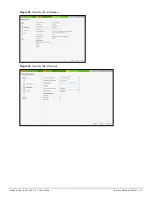
Aruba Instant 6.5.0.0-4.3.0.0 | User Guide
VLAN Configuration |
77
Chapter 8
VLAN Configuration
This chapter explains the following topics:
l
l
Uplink VLAN Monitoring and Detection on Upstream Devices
VLAN configuration is required for networks with more devices and broadcast traffic on a WLAN SSID or wired
profile. Based on the network type and its requirements, you can configure the VLANs for a WLAN SSID or
wired port profile.
For more information on VLAN configuration for a WLAN SSID and wired port profile, see
Settings for a WLAN SSID Profile on page 87
and
Configuring VLAN for a Wired Profile on page 109
respectively.
VLAN Pooling
In a single IAP cluster, a large number of clients can be assigned to the same VLAN. Using the same VLAN for
multiple clients can lead to a high level of broadcasts in the same subnet. To manage the broadcast traffic, you
can partition the network into different subnets and use L3-mobility between those subnets when clients
roam. However, if a large number of clients need to be in the same subnet, you can configure VLAN pooling, in
which each client is randomly assigned a VLAN from a pool of VLANs on the same SSID. Thus, VLAN pooling
allows automatic partitioning of a single broadcast domain of clients into multiple VLANs.
Uplink VLAN Monitoring and Detection on Upstream Devices
If a client connects to an SSID or a wired interface with VLAN that is not allowed on the upstream device, the
client will not be assigned an IP address and thus cannot connect to the Internet. In such scenario, the Instant
UI now displays the following alert message:
Figure 25
Uplink VLAN Detection
To resolve this issue, ensure that there is no mismatch in the VLAN configuration.
















































